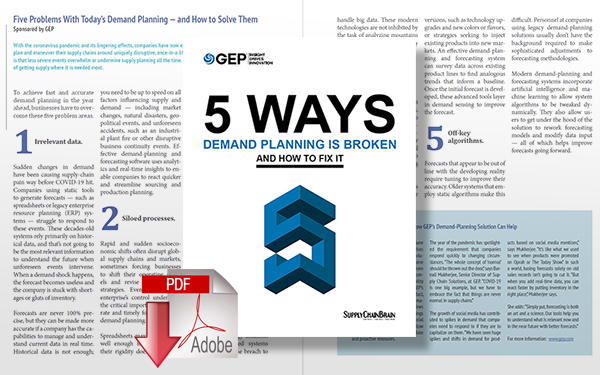5 Reasons Next-Generation Demand Planning is Essential to Your Supply Chain

In this informative and educational article, we detail five ways your current demand planning processes can be letting you down, and five reasons next-generation demand planning is essential for your supply chain.
How to Get Over Demand Planning Shortcomings
- Accurate demand planning takes more than just limited or historical data
- Next-generation demand planning depends on collaboration
- Responding to demand shifts in real time is a necessity, not a luxury
Amid this pandemic, there is a lot of pressure on supply chains to sense demand accurately and perform flawlessly.
But how often do companies get their demand planning right on the money, and how much inefficiency is there in the supply chains as a result of missing the mark?
Here are five ways your current demand planning processes can be letting you down, and five reasons next-generation demand planning is essential for your supply chain.
1) You’re relying too much on historical data – Past performance in the form of sales numbers might be a good starting point for understanding what happened. But there’s so much more data available now. Demand planning should incorporate that data, which is often siloed in various locations and systems, as well as non-historical, real-time data such as weather patterns and social media activity.
2) Team members and stakeholders aren’t fully invested – It’s a commonplace to say that “the forecast is always wrong,” whether you’re talking about the weather or demand planning. That just programs people to distrust the process and inhibits effective collaboration.
3) You’re not planning in real time – If you’re not basing your plans on the most up-to-date data, it’s likely you’re going to miss things. Sensing and responding to changes in real time should be a part of the demand planning process, and that starts with properly capturing all the data and putting it to the right use.
4) You’re not coordinating effectively – Lack of communication between all the nodes in your supply chain value chain makes it all too easy to create a bullwhip effect that throws your demand plan off course.
5) There are too many silos – Breaking down the silos that exist within your company and your supply chain helps make sure that all the data from suppliers, warehouses and logistics is available to analyze in your demand planning process. Having that visibility is a key factor in getting demand planning right.
All these problems represent opportunities to improve your demand planning process and optimize your supply chain.
With the capabilities of next-generation demand planning tools, you can take the following steps to help solve them:
1) Establish a unified data model to store information from the individual points across your supply chain and provide a platform for analyzing historical and non-historical data.
2) Change the mindset that the forecast is always wrong – by providing enhanced demand forecasting to help you plan more accurately.
3) Harness AI/machine learning to find hidden trends you may be missing and analyze the impacts to your demand plan of potential threats.
4) Operate in real-time to sense and respond to demand issues before they happen.
5) Collaboration tools to help share demand plans and forecasts, develop consensus among your supply network on opportunity and availability, and coordinate demand and supply efficiently.
The Cornerstone of a High-Performing Supply Chain Operation
With the speed at which disruptions unfold, the need for precision and speed in demand planning has never been greater.
Next-generation demand planning software empowers you to solve critical challenges in real time by breaking your data out from organizational silos, leveraging AI-powered analytics, and empowering your people through collaboration.
Related Resource
5 Ways Demand Planning is Broken and How to Fix it
In this paper, 5 Ways Demand Planning is Broken and How to Fix it, we detail how to achieve fast and accurate demand planning and five problem areas businesses have to overcome. Download Now!
More Resources from GEP
Article Topics
GEP News & Resources
Enhance Procurement Efficiency with Generative AI Unlocking Procurement Potential: Total Orchestration Explained Unlocking Supply Chain Resilience: Total Inventory Management Solutions Navigating Procurement’s Digital Transformation with AI GEP Procurement & Supply Chain Tech Trends Report 2024 How Procurment and Supply Chain Leaders Should Handle Supply Chain Disruptions Optimizing Business Outcomes by Investing in Sustainable Supply Chains and Procurement More GEPLatest in Supply Chain
Talking Supply Chain: What is going on along the Mexican border? Why Companies Should Look to LLMs, Not Chatbots, For Their AI Needs Retail Supply Chains Embrace AI to Improve ESG Compliance Optilogic and GM Form Partnership to Improve Supply Chain Efficiency Bellingham and San Diego Ports Secure Key RAISE Grants for Infrastructure Coyne Airways First to Offer Dangerous Goods Booking via WebCargo South Carolina Ports Halts Construction to Clear Vessel Backlog More Supply Chain














